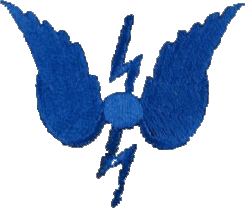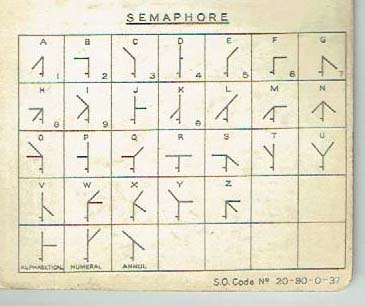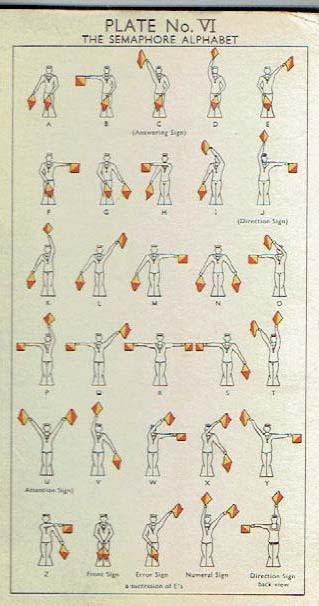


A BRIEF HISTORY OF SEMAPHORE
Author unknown
©RN Communications Branch Museum/Library
Clicking on an image will enlarge it. The enlarged image will open up as a pdf file in order for you to use the tools to enlarge the image even further.
The closing years of the eighteenth century were remarkable for the introduction of the telegraph in various forms. On the continent of Europe the French system, invented and perfected by Citizen Claude Chappe in 1792, had in a few years become widespread and stretched in all directions. It consisted of an upright post having a pivoted beam at the top, and at the ends of the beam two further smaller pivoted arms, so that both the beam and the arms could be turned in various directions at the same time. It was called the "T" telegraph, as when it was at rest it resembled the letter T, the two smaller arms forming the top serifs. Chappe became almost a national hero, and a statue was afterwards put up to his memory in Paris at the Rue de Bac, This distinguished monument was removed and sent to be melted down by the Germans in 1942.
Although the "T" telegraph could hardly be considered a maritime development, it doubtless inspired English telegraphers to turn their attention to the possibilities of imitating Chappe. In England the Rev Lord George Murray, son of the Duke of Atholl and Bishop of St. David's, was the first inventor to attain any real success. His plan was to have a large vertical frame in which were pivoted six shutters, louvers, or "valves". The shutters were poised open, and pulled shut by the operation of chains or ropes, much after the style of bell-ringing. Between 1796 and 1808 sixty-four stations had been built and all were in working order, keeping Plymouth up communications from the Admiralty in London to Portsmouth, Chatham, Sheerness, Deal, and Yarmouth. These stations were given up in 1814, as telegraphs were considered entirely unnecessary.
However, a few years later it was decided that similar lines to Portsmouth and Plymouth would be an advantage for speedy communication with the admirals of those two Home Ports, even in days of peace. This time the semaphore of Sir Home Popham was chosen, a tall machine having two arms on separate pivots, one at the top of the 30-foot post, the other 12 feet below it. The shutter telegraph frames had been mounted on the roofs of primitive huts or cottages but the new semaphores were erected on costly and substantial buildings of one storey, two stories or towers of five stories, according to the elevation of the place with respect to its neighbouring stations. Of the tower type only two were built, at Chatley Heath at Cobham and Worplesdon in Surrey. The tower at Chatley Heath is still standing, and eight of the other houses in Surrey, Sussex and Hampshire still survive in a good state of preservation. The new Portsmouth line was in full working order in 1822 and was only given up in favour of the electric telegraph on the last day of 1847. The projected line to Plymouth never reached beyond the borders of Hampshire and Dorset and was abandoned, and so did not function. The complement of a semaphore station was only a lieutenant and one man; both had probably been incapacitated in war and thought themselves lucky to have the berth.
It is obvious that the stations could not be constantly working, and there was no provision for night signalling. An equally successful telegraph ran between Holyhead "Mountain" and Liverpool and did valuable work in reporting the movements of merchant ships from 1827 to 1861, long after the electric telegraph had been installed in other parts of the country. The first manager was Lieutenant B.L. Watson R.N., and the first apparatus consisted of three pairs of semaphore arms on a single mast. In 1851 Watson bettered himself by organising other telegraph lines in other parts of the country on a commercial basis; then the Holyhead line devolved upon another naval officer, Lieutenant William Lord, who much improved it, the stations now being more numerous and equipped with two lattice masts side by side each carrying two pairs of semaphore arms, The line ran right across Anglesey an spanned Beumaris Bay, the estuary of the Dee, and the River Mersey, and last station but one being on Bidston Hill near Birkenhead. Four of the stations are still standing in good preservation, four others are more or less ruinous, and of three more there is not trace today.
The term "semaphore" for a telegraph station has been very loosely and unintelligently used in the past, but it is as well to remember that the word was first coined by the French in 1801 to describe the apparatus that they set up all along the coasts of France and her dependencies. It was not until the year 1810 that semaphores were definitely introduced into England, when the various stations along the east coast were first converted from the old system of signalling with flags and balls, into semaphores consisting of a single post with three separate arms.
At a period when so many different inventors were striving to produce a telegraph that could be easily operated, it is strange that the semaphore introduced by Colonel Pasley of the Royal Engineers was received so reservedly, for its simplicity made it far more valuable that any of the other complicated methods. After several experiments his machine finally ended up in 1822 in the well-known form adopted nearly all over the world.
It was only in 1943 that mechanical semaphores on Pasley's plan were abolished in sea-going ships of the Royal Navy owing to the need to reduce top weight. Although recognised in 1827, this machine was really intended as a telegraph and confined to shore stations and harbour flagships, and spelling out a message was of secondary interest partly because some of the letters were not complete, for instance, the setting "13" indicated either I or J, "25" indicated Q or X, and "35" indicated U, V or W. This explains why the letters, J, V, W and X are today not in their right order. It was not till 1874 that Pasley's machine was adopted at sea as a method of conversational signalling, and it was not till about 1880 that anybody thought of adapting the arms of the human body to imitate the arms of Pasley's machine, for, incredible though it may seem, where a small replica of the machine was used, the operator stood behind it and actually grasped its arms with his hands and moved them into position However, the manual version soon spread and was often in use as the mechanical, and had the advantage that it could be employed wherever a man could stand up.
Meanwhile, after some other experiments with machines on the masts, the true semaphore was introduced in 1895 by Captain (afterwards made Admiral of The Fleet) Arthur Wilson. It was fitted at the main masthead in all men-of-war from battleships to scouts, and consisted of two sheet-metal arms 12 feet long and 15 inches wide. It was capable of being trained round from beam to beam and was worked by handles at deck level. It was supposed to be exercised daily but was rarely used in real earnest, although it had a horizon range, Wireless Telegraphy was beginning to make some headway in 1902, and at first flagships and cruisers were fitted with it. The vertical aerial was suspended from a sort of fishing-rod gaff at the main mast head and for some years shared the position with the truck semaphore, the visual apparatus being retained for the present "In case". Mast semaphores were abolished in 1907.
CHATLEY HEATH SEMAPHORE TOWER
The Royal Navy supported the official opening of the now restored Chatley Heath Semaphore Tower in support of the official open day on Friday 10 September 2021. AB Lorcan O?Toole, loaned from the Seamanship Training Element demonstrated how the tower would have worked and the link to modern visual signalling in the Royal Navy, using the Mechanical Semaphore Trainer provided by the Communications Branch Museum who also provided a number of photographs and a description of the Horse Sands Fort Semaphore Mast which were framed and the former 1st Sea Lord Admiral Sir Philip Jones GCB, ADC, DL presented this montage to Dr Anna Keay OBE, Director of The Landmark Trust and Captain Nick Kettlewell presented a set of flags denoting the famous signal from the Battle of Jutland, a?Equal Speed Charlie London? to highlight the importance of visual signalling in support of Royal Navy operations.

Telegraph Semaphore Trainer
The Telegraph Semaphore trainer was introduced in 1874 on HMS VICTORY, worked manually, by use of the operator holding the arms in the appropirate position. 6 feet in height and constructed of rather cumbersome sprockets and chains made to a special Admiralty pattern. In 1941 the firm of Thomas Haywood realized that ordinary bicycle chains would be cheaper and equally effective. Sets such as this were delivered to the Signal School at Chatham to be used as a training aid. In 1942, HMS CABBALA installed small mechanical semaphores for training V/S Wrens, just a year before mechanical semaphores were finally withdrawn from ships to save top-weight. This is one of the few remaining mechanical semaphores, as used at both the Signal School at Chatham and HMS CABBALA, and is identical to the bigger mechanical semaphores introduced to the fleet in 1874.
The Horse Sand Fort semaphore mast now resides outside Mercury Building, HMS COLLINGWOOD and was originally commissioned by Admiral Phillip Jones in 2005 to provide the link between that Tower and the Royal Navy in Portsmouth. The Royal Navy Team was headed up by former 1SL Admiral Sir Phillip Jones GCB, ADC, DL, Captain Nick Kettlewell RN Rtd, Mr Ken Sutton Curator Communications Branch Museum, Lt Cdr Paul Santry and AB Lorcan O?Toole.
A short video of the day
A Brief History of Chatley Heath Semaphore Tower
A unique remnant from the Napoleonic era, this Grade II* listed brick structure is the only surviving semaphore tower in Britain. It was once a building at the forefront of technology and design, a vital link in a signalling chain that transmitted messages from Admiralty House in London to Portsmouth Docks in just a few minutes.
It stands deep in ancient heathland near Wisley in Surrey. In 1989 the Tower was restored by Surrey County Council in association with The Surrey Historic Buildings Trust to commemorate the Centenary of the County Council and was opened by Admiral Sir Jeremy Black KCB, DSO, MBE on the 15 the July 1989.
The construction of the line was ordered in 1816 in the aftermath of the Battle of Waterloo, when foreign invasion still seemed a real possibility.
In 1847, the semaphore lines were decommissioned. Heath wardens and gamekeepers lived in the tower until 1963, when the lack of modern services made it no longer habitable. Left empty, it suffered vandalism and then was gutted in a major fire in 1984. In 1988, Surrey County Council carried out a full restoration to mark the 100th anniversary of their founding under the Local Government Act of 1888, with the help of Surrey Historic Buildings Trust. Water and electricity were brought in and the tower was let residentially. Its care passed to the Surrey Wildlife Trust, which manages the Chatley Heath Site of Special Scientific Interest around the tower.However, the detailing of the tower in this exposed site had been a problem in both original and restored forms. 30 years on, water ingress at the base of the mast and around the windows was again causing problems beyond the SWT?s remit or resources.
The Landmark Trust was called in as a specialist organisation that could also provide a new use for the tower to pay for its future maintenance. The tower was completely re-wired and ?plumbed, and the roof re-leaded. Windows were repaired and replaced where necessary, and a new kitchen and bathrooms were created. The mast and its arms (which can still be operated for open days etc. but are kept fixed in between) has been completely overhauled and repainted its original red oxide colour. The stairs and chimneypieces date to the 1988 restoration: as they are entirely in keeping with the original period, we have kept them.
The Landmark Trust, supported by the generosity of over 1,152 supporters began work in early 2020 to sympathetically restore the five-storey structure. Despite the Coronavirus pandemic works continued throughout the difficult year and was featured in BBC?s Countryfile visited in August 2020.
The structure can now be booked through the Trust to rent out for short vacations. The semaphore machinery has been refurbished, providing a living lesson in technological and engineering history and was demonstrated on the official open day thanks to the Guardians, Patrons and Lead Supporters of the Tower.

For an update on visiting the Tower and directions to get their it is recommended you look at this site: Ian Visits Chatley Heath Semaphore Tower
Semaphore Plates from 1937 and 1952

 |
 |